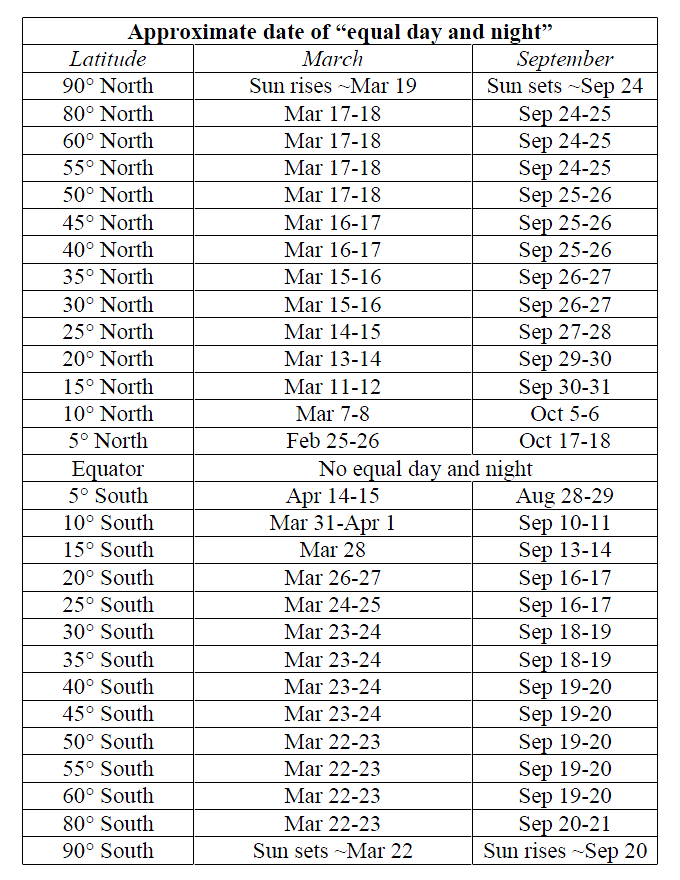Difference between revisions of "The Equinox"
Tom Bishop (talk | contribs) |
Tom Bishop (talk | contribs) |
||
| Line 29: | Line 29: | ||
{{cite|The date at which the time between sunset and sunrise crosses 12 hours is known as the equilux. Because sunset and sunrise times vary with an observer's geographic location (longitude and latitude), the equilux likewise depends on location and does not exist for locations sufficiently close to the equator.}} | {{cite|The date at which the time between sunset and sunrise crosses 12 hours is known as the equilux. Because sunset and sunrise times vary with an observer's geographic location (longitude and latitude), the equilux likewise depends on location and does not exist for locations sufficiently close to the equator.}} | ||
| + | |||
| + | |||
| + | A chart which appears on page 39 of a document entitled "Ancient Observatories - Timeless Knowledge" which was compiled in 2015 by Deborah Scherrer for the Standford Solar Center. | ||
| + | |||
| + | [[File:Equilux table.png]] | ||
Revision as of 17:39, 1 October 2018
Myths
Direction of Sunrise and Sunset
From The Permaculture Research Institute we read the following:
“ Why is the equinox important for permaculture?
One of the first questions my PDC instructor posed to us was, “where does the sun rise?" Well everyone knows the answer to that; the sun rises in the east. No brainer. Alas, we were wrong. Unless you live at the equator, the sun does not rise directly in the east. ”
Equal Day and Night
From an article from the Christian Science Monitor we read the following:
“ It's often said that the autumnal equinox is a day of perfect equilibrium – a 24-hour cycle split neatly into 12 hours of light, and 12 hours of dark. That's not exactly true. In areas distant from the equator, the sun can take longer to rise and set; closer to the equator, the day lasts a little more than 12 hours. The real even split between day and night doesn't occur until later in the fall, according to the US Naval Observatory. ”
The Equilux
From The Macmillan Dictionary we read the following:
“ The equinox occurs twice a year, usually around 20th March (the Spring equinox in the Northern Hemisphere, after which day becomes longer than night) and 22nd September (the Autumn equinox in the Northern Hemisphere, from when night becomes longer than day). On these days however, the length of the day and night is only 'nearly' equal. This is because the top half of the sun rises above the horizon before the centre, and sunlight is refracted by the Earth’s atmosphere, meaning that the sun appears to have risen when its centre is still below the horizon. This makes the amount of daylight longer than expected on those days (12 hours and 10 minutes in the UK). However the same effect means that on the equilux, which is in fact a few days before the Spring equinox and a few days after the Autumn equinox, the hours of daylight and darkness are exactly equal.
By now you may, as I did, be wondering why on earth (no pun intended!) we’re all so familiar with the term equinox, when in fact it’s a less equal split of day and night hours than the not so commonly known equilux. One possible explanation is that the equinox is a fixed instant in time, referring to the moment when the sun crosses the equator and completely independent of the observer’s location, whereas the equilux is a moveable feast, its date varying depending on where in the world you are. In fact close to the equator, equiluxes don’t occur at all. ”
The Equinox in Contrast to The Equilux
http://www.torahcalendar.com/ORBITS.asp?HebrewDay=22&HebrewMonth=7&Year=2018
“ The date at which the time between sunset and sunrise crosses 12 hours is known as the equilux. Because sunset and sunrise times vary with an observer's geographic location (longitude and latitude), the equilux likewise depends on location and does not exist for locations sufficiently close to the equator. ”
A chart which appears on page 39 of a document entitled "Ancient Observatories - Timeless Knowledge" which was compiled in 2015 by Deborah Scherrer for the Standford Solar Center.

